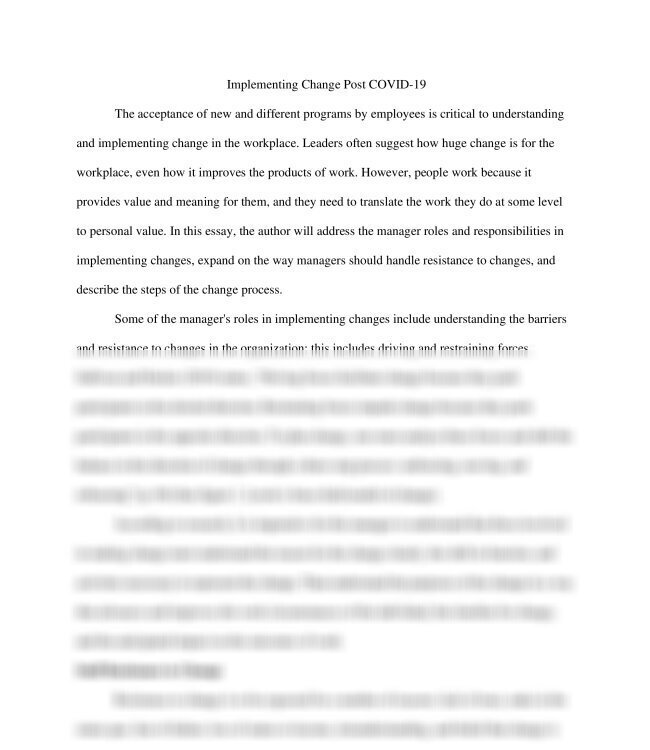Implementing Change Post COVID-19 The acceptance of new and different programs by employees is critical to understanding and implementing change in the workplace. Leaders often suggest how huge chang
Implementing Change Post COVID-19 The acceptance of new and different programs by employees is critical to understanding and implementing change in the workplace. Leaders often suggest how huge chang
& (1989). (2007) (2007). (2008, (2009) (2009). (2019) (7th (Ford, (Katz (O’Grady (See (Sullivan (p. (pp. . 1. 10. 169-183. 17(3), 1978). 2. 20-22). 2007). 2008). 2009). 2009, 3. 33(2), 4. 5. 50% 69) 70) 70). 80% 90% A A. A., Academy According Amelio, Analysis, Analyze April). Assessment At Barriers Be Boundaries Bushy, COVID-19 Can Change Collect Couch D'AMELIO, D., Data. Decker Decker, Discrepancies Driving E. Effective Effectiveness Emphasis Establish Evaluation Ford, Hall. However, If Implementation Implementing In International It J. J., Journal K. Kahn, Kamphuis L. Leaders Lewin’s Louis, MO: Malloch Malloch, Management Managers Managing Members Mosby NJ: One Opportunities Organizational O’Grady P. Pearson Perceptions, Planning Plant Porter-O’Grady, Post Prentice Present Providing PubMed. References Regardless Research Resistance Restraining Retrieved Review, River, Saddle Setthasakko, Some St. Staff Start Sullivan Sullivan, T., Thailand: Than The This To Training Unintended Upper Using W. W., What When Who Without a about acceptance achieved act active activities actors. acts address addressed advances affairs. affect agent agrees aids, altered?” amount amounts, an analysis analysis, analyze analyzed. analyzing, and anticipated anxiety approach. are areas areas, arise around as as, asking assess assessment at attain attitudes, author authority balance bar barriers based bases be be? because becomes been before begin behaving. behaviors belief benefits better between binding both build business but by can care. case change change). change, change. change? change?” changes changes, change– changing charts circumstances clearly, clearly. climate, close closely cogently collected collected, collecting, collection collects combines comes comfortable communicate company, competitors compliance compliance. composed conclusion, confidence confused. consensus, consequences control corporate created. creates critical crucial data data, data. decisions decisions? decrease define degree delegating demand department depending depends describe design desired determines develop different differently, directed direction direction. discontent discrepancy discuss discussions.” dissatisfied do do, do? does doi:10.5465/AMR.2008.31193235 doi:http://dx.doi.org/10.1108/19348830910974905 driving duplicate e.g., each ed.). effort, emphasize emphasized employee employees energizer energizer, enough environmental especially essay, establish established evaluate even eventual evolutional expand expected explain explaining extended extent external facilitate fact, failure failure, failure. fear feedback feedback, feedback. figure final financial find findings, flush focus followed. for force-field forces forces. four-step from function, gain giving go? goals good graphs, greatest group group. groups habits, handle has have health helping here. honestly how how, http://www.ncbi.nlm.nih.gov/pubmed/2605559 huge idea identified identify if if” imagery impact impede imperative implementation implementation, implementing important important, improve improves in inadequate include includes including income, increase indicates indicators individual, individuals individuals, inevitable influence information initiating interested internal interventions into introducing involved involving is issue issues it its itself. key kind kinds, known lack later. leadership less level likely lose? loss made; maintain make making management manager manager's managers may meaning mechanisms melt members members. method methods minimize misunderstanding, model monitored. more most motion, moving moving, much must necessary need needed needed. new new. not now? number nursing obstacle obstacles obtains, occupy occurred. of often on one only openly operational opportunity, oppose opposite option or orders, organization, organization. organization; organization? organizational other others our out outcome outcomes overcomes overlooked. p. participants past patient people perceive perceived perform performance periods. personal persons perspective, persuade phase physician pilot placed plan planned planning plans point point, points political positions positive possesses. possible, potential power power. practice preoperative prerequisite present presented presumed prevents problem problems problems, proceed process process. process: products profitability programs progress proposed provide provides pulse. purposes push put qualitative quantitative questionnaires questions quo, quo. rather reaching ready reason reasons reasons. reasons: reduced. refreezing” refrozen. reinforce reiterate related relationship relevant relevant, represent required required?” research research, resistance resistance, resistance. resistive resources responsibilities responsibility restraining restructure. right role roles satisfaction satisfaction. search seeds selected. services set setting shift should shows signal significance significant situation skill so soften solutions some something sources specific staff stage, stage. stake state states, statistical status step step. steps still stimulus strategies strategies, success success. succinctly such suggest summarizing support supportive surface, surveys. system system. tactics target terminates terms terms, test than that the them, there these they thinking this those three three-step through time time, timeline to toward training translate trust, two typically uncomfortable understand understanding undesirable unfreezing unfreezing, unique unless unnecessary us us? use used, useless using value value. values visual waiting way ways we well were what when whereas whether whichever who who, why? will wish with work work. workplace, workplace. worth “Driving “The “What “Where “Who “wouldn’t
Implementing Change Post COVID-19
The acceptance of new and different programs by employees is critical to understanding and implementing change in the workplace. Leaders often suggest how huge change is for the workplace, even how it improves the products of work. However, people work because it
